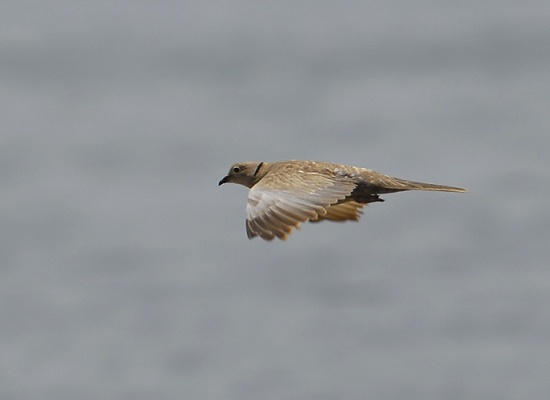Alternative names: Barbary Dove, African Turtle Dove, Pink-headed Collared Dove, Ringed Turtle Dove, Rose-grey Dove
- Streptopelia roseogrisea
Identification
26 cm (10 in)
- Pale creamy buff
- White chin, belly and undertail coverts
- Black half-collar around back of neck
- White undertail coverts
- Red eye with white eye ring
- Black bill
- Crimson feet
Similar Species
Eurasian Collared Dove (which see) is very similar in plumage, but slightly larger, and with a very distinct voice. Mourning Collared Dove overlaps slightly in range in the US but generally occurs further south. It differs in having a red (not white) eye ring, and a yellow (not red) iris; it also has a slightly broader black collar.
Distribution
The Sahel region of Africa and the far southwest of the Arabian Peninsula in southwest Asia, in a narrow band between 11-20°N latitudes. Occurs at the southern edge of the Sahara Desert, in southern Mauritania, Senegal, Gambia, Mali, Burkina Faso, northern Benin, northern Nigeria, Niger, Chad, northern Cameroon, Sudan, Eritrea, Ethiopia, Djibouti, Somalia, Saudi Arabia, and Yemen.
Introduced to New Zealand as a cage bird but has become feral. A frequent escape in the United States, and feral in Hawaii.
Taxonomy
Barbary Dove, only known from captivity and formerly sometimes counted as a full species (Streptopelia risoria), is currently believed to be a captive variant of this species. Another interpretation is that African Collared Dove should be renamed to Streptopelia risoria because it is the senior synonym, but this has been ruled inadmissible by the International Code of Zoological Nomenclature as that is a name based on a domesticated animal[2]. Many feral Barbary Dove populations are leucistic to a greater or lesser degree.
Subspecies
Two subspecies are accepted [1]:
- S. r. roseogrisea: Southwestern Mauritania and Senegal to southern Sudan and western Ethiopia
- S. r. arabica: Coastal Eritrea, Ethiopia and Somalia to Arabia
Habitat
Savanna and thorn scrub.
Behaviour
Noted for their gentle nature.
Diet
They eat clover and weed seeds, split grain and newly sown or stubble grain supplemented with occasional invertebrates such as snails.
Breeding
Breeding is mainly between October and February and they re-nest several times a season. They lay 2 white eggs on a simple platform of twigs. Both adults incubate for about 15 days and the chicks fledge at about 15 days old
Vocalisation
Call: a persistent coo-crooo.
References
- Clements, J. F., T. S. Schulenberg, M. J. Iliff, D. Roberson, T. A. Fredericks, B. L. Sullivan, and C. L. Wood. 2014. The eBird/Clements checklist of birds of the world: Version 6.9., with updates to August 2014. Downloaded from http://www.birds.cornell.edu/clementschecklist/download/
- ICZN Case 3380
- Avibase
Recommended Citation
- BirdForum Opus contributors. (2025) African Collared Dove. In: BirdForum, the forum for wild birds and birding. Retrieved 21 January 2025 from https://www.birdforum.net/opus/African_Collared_Dove
External Links
GSearch checked for 2020 platform.






